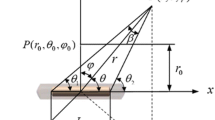Abstract
The possibilities for optimizing brachytherapy by including additional degrees of freedom in source design were investigated. This included examining optimised dose delivery with a brachytherapy source that can provide intensity-modulated dose delivery in angle about the source travel direction (to achieve intensity-modulated brachytherapy-IMBT). A prostate HDR case was selected as an example. An inverse planning algorithm was used to define how an asymmetric radiation source can be controlled in multiple source catheters to maximize tumour dose coverage and minimize urethral and rectal doses. Substantial improvements in conformity in terms of tumour coverage and urethral dose reduction could be achieved when conventional HDR source positioning was used with IMBT. With the objective definition used in the example however, rectal doses could not be improved over those delivered via conventional HDR. When source position was included as a variable in IMBT, significant conformity improvements result for all structures. IMBT would be a technically challenging form of therapy that would be strongly influenced by the type of sources that could be created for it. This study has shown however that there is a potential for improving dose conformity with such a therapy. Introduction of IMBT techniques would require conventional brachytherapy concepts to be radically modified.
Similar content being viewed by others
References
Sloboda, R. S., Pearcey, R. G., Gillan, S. J.Optimized low dose rate pellet configurations for intravaginal brachytherapy. Int J Radiat Oncol Biol Phys 1993; 26: 499–511.
Kneschaurek, P., Schiessl, W., Wehrmann, R.Volume-based dose optimisation in brachytherapy. Int J Radiat Oncol Biol Phys 1999; 45: 811–815.
Kolkman-Deurloo, I. K., Visser, A, G., Niel, C. G., Driver, N., Levendag, P. C.Optimisation of interstitial volume implants, Radioth Oncol 1994; 31: 229–239.
Edmundson, G. K., Yan, D., Martinez, A. A.Intraoperative optimisation of needle placement and dwell times for conformal prostate brachytherapy. Int J Radiat Oncol Biol Phys 1995; 33: 1257–1263.
Giannouli, S., Baltas, D., Milickovic, N., Lahanas, M., Kolotas, C., Zamboglou, N., Uzunoglu, N.Autoactivation of source dwell positions for HDR brachytherapy treatment planning. Med Phys 2000; 27: 2517–2520.
Sadegh, P., Mourtada, F. A., Taylor, R. H. Anderson, J. H.Brachytherapy optimal planning with application to intravascular therapy. Medical Image Analysis 1999; 3: 223–236.
Lessard, E., Pouliot, J.Inverse planning anatomy-based optimisation for HDR-brachytherapy of the prostate using fast simulated annealing algorithm and dedicated objective function. Med Phys 2001; 28: 773–779.
Cetingoz, R., Ataman, O. U., Tuncel, N., Sen, M., Kinay, M.Optimisation in high dose rate brachytherapy for uterovaginal applications. Radioth Oncol 2001; 58: 31–36.
Messing, E. M., Zhang, J. B., Rubens, D. J., Brasacchio, R. A., Strang, J. G., Soni, A., Schell, M. C., Okunieff, P. G., Yu, Y.Intraoperative optimized inverse planning for prostate brachytherapy: early experience. Int J Radiat Oncol Biol Phys 1999; 44; 801–808.
Lachance, B., Beliveau-Nadeau, D., Lessard, E., Chretien, M., Hsu, I. C., Pouliot, J., Beaulieu, L., Vigneault, E.Early clinical experience with anatomy-based inverse planning dose optimisation for high-dose-rate boost of the prostate. Int J Radiat Oncol Biol Phys 2002; 54: 86–100.
Yang, G., Reinstein, L. E., Pai, S., Xu, Z., Carroll, D. L.A new genetic algorithm technique on optimisation of permanent 125 I prostate implants. Med Phys 1998; 25: 2308–2315.
Yu, Y., Zhang, J. B., Brasachio, R. A., Okunieff, P. G., Rubens, D. J., Strang, J. G., Soni, A., Messing, E. M.Automated treatment planning engine for prostate seed implant brachytherapy. Int J Radiat Oncol Biol Phys 1999; 43: 647–652.
Lee, E. K., Gallagher, R. J., Silvern, D., Wuu, C. S., Zaider, M.Treatment planning for brachytherapy: an integer programming model, two computational approaches and experiments with permanent prostate implant planning. Phys Med Biol 1999; 44: 145–165.
Pouliot, J., Tremblay, D., Roy, J., Filice, S.Optimisation of permanent 125 I prostate implants using fast simulated annealing Int J Radiat Oncol Biol Phys 1996; 36: 711–720.
Hetzel, H., Kamleitner, H., McCoy, M., Frommhold, H.Rectal shielding for a Selectron-ring applicator system (HDR and LDR-afterloading).Strahlen Onkol, 1987; 163: 782–786.
Sloboda, S., Wang, R.Combined experimental and Monte Carlo verification of 137 Cs brachytherapy plans for vaginal applicators. Phys Med Biol 1998; 43: 3495–3507.
Weeks, K. J., Montana, G. S., Bentel, G. G.Design of a plastic minicolpostat applicator with shields. Int J Radiat Oncol Biol Phys 1991; 21: 1045–1052.
Kron, T., Haque, M., Foulkers, K., Jeraj, J.A flattening filter for brachytherapy skin irradiation. Phys Med Biol 2002; 47: 713–722.
Jeraj, R., Sarvary, A., Kron, T.Optimal flattening filter shape of a surface brachytherapy applicator. Phys Med Biol 2002; 47: 723–735.
Ebert, M. A.Possibilities for intensity-modulated brachytherapy: technical limitations on the use of non-isotropic sources. Phys Med Biol 2002; 47: 2495–2509.
Gierga, D. P., Shefer, R. E.Characterization of a soft x-ray source for intravascular radiation therapy. Int J Radiat Oncol Biol Phys 2001; 49: 847–857.
Author information
Authors and Affiliations
Corresponding author
Rights and permissions
About this article
Cite this article
Ebert, M.A. Potential dose-conformity advantages with multi-source intensity-modulated brachytherapy (IMBT). Australas. Phys. Eng. Sci. Med. 29, 165–171 (2006). https://doi.org/10.1007/BF03178889
Received:
Accepted:
Issue Date:
DOI: https://doi.org/10.1007/BF03178889




